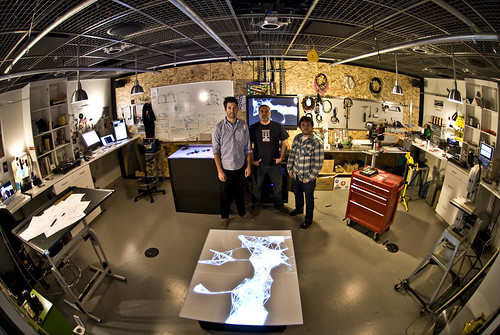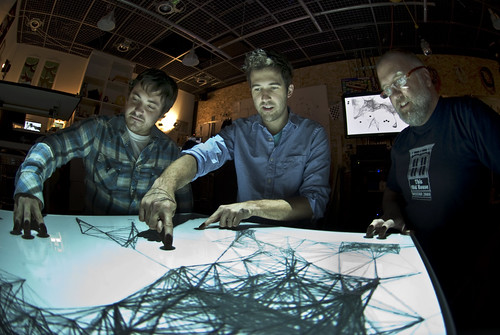 The Lab was featured in Creativity last week which is totally cool but, you know whats totally uncool? They make you pay for articles that’ve been on their site for more then 7 days. Boooooo To That.
The Lab was featured in Creativity last week which is totally cool but, you know whats totally uncool? They make you pay for articles that’ve been on their site for more then 7 days. Boooooo To That.
Soo… You can download it here.
or just read it below… Enjoy.
Arnold unveils its R&D Lab
Young technologist-designers start manufacturing innovation in Boston.
By: Nick Parish Published: Apr 28, 2008

Touchscreen interfaces, RFID tags and other hi-tech elements now coexist with storyboards and strategy meetings at Arnold, Boston–the agency has announced a research and development lab tasked with creating new media channels and different ways for clients to communicate with consumers.
Chief creative officer Pete Favat is behind the project, which has creative director Meg Siegal overseeing two lab staffers– Ryan Habbyshaw, 25, an agency art director/designer, and Todd Vanderlin, 23, who studied at Parsons School of Design. According to Favat, Habbyshaw and Vanderlin are in dense, technological clover—not worrying about clients, pitches, or the standard doings of advertising.
“I wanted to put a couple of people in place who are not concerned with or thinking about the day-to-day brand messages, with what we have to do for Jack Daniels, truth, or Tag, but are coming up with software, coming up with different technologies, whatever we can to dispense new ideas out in the world,” Favat says. “I told them ‘The day you guys think about certain brands is the day you lose your job.’ Their mantra is to just play; I don’t want them to ever worry about being attached to a client.”
Some of the concepts the two are involved in and have recently blogged about include touch and flocking interfaces, eye tracking, large-scale projections, RFID, computer vision, sensory design and physical computing applications. Favat talks about changing guerilla marketing into “surprise media,” creating concepts in the six month-old lab to grab clients’ attention. “If we’re going to succeed in this business we’re going to have to be finding all new ways to speak to people,” he says. “We’re living in the world of too, too much, too fast.”
As for the physical lab itself, it’s a 20-by-12 area across from Favat’s office. “It feels like electronics-slash-metal shop when I was in high school,” Favat says. He says Habbyshaw and Vanderlin tinker in the lab, and brand teams come by to see how the different things on display could work for their clients. Already, he adds, three concepts have been approved by clients to move forward.
This is where things get slightly sticky. The bill for innovation in the R&D lab comes right to Arnold. The budget item isn’t billable to any client; it’s straight overhead. So ownership over the things developed inside, as well as the potential windfall they might generate, becomes an issue.
“Those are discussions that are happening upstairs, rights and ownership,” Favat says. “These guys are really young and they’re really into open source, I was talking with them the other day and said Guys, I’m from New Jersey. I come from a day where if it’s not bolted down, I’m taking it. I’m a little paranoid about the whole open source thing, but you want to try and embrace it.
Favat wouldn’t comment on whether or not Arnold would retain a stake in any eventual client-backed projects that sprang from applications developed in the lab.
“It’s like a lot of manufacturing. Some people say we’re in the service business; we’re in the product business, the entertainment product business. In a manufacturing company there is an R&D budget that Apple or Microsoft or anybody is going to put billions aside for. But ad agencies don’t do that. In a lot of ways I would question that. Is your agency investing in areas that are extremely nontraditional? We’re putting up our own money to find these ways.”
Another attractive aspect of the financial picture is the low cost-to-benefit ratio of emerging technologies. “I personally get sick to my stomach sometimes with what it costs in [film] production and television media,” Favat says. “It really is way out of control…I think the real value today is not the amount of eyeballs but consumer engagement, time spent, is almost more valuable than mass eyeballs. Once you commit things to film, it’s committed. But how can we engage consumers and add onto [the brand message] or make it better or have it change?”
This is the second of Favat’s projects to bring in thinking from outside advertising’s orbit; the agency hired cognitive scientist Dr. Lisa Haverty to run an intuition analytics department last year. “I think…I’m creating jobs I want to live vicariously though.”


